Manila ForeverPrepared by Harold Stephens
Travel Correspondent for Thai Airways International
Pick up a guide book of Manila, any guide book, and it will tell you that Manila is the capital of the Philippines with a population of over 12 million. To say the least, that’s a big city. Then the chances are the guidebook will tell you that Manila is little more than a starting point for the rest of the Philippines. That is true, but there more to the city than that. If you know where to look, and what to do, it can be interesting.
One should not, however, judge Manila on its past laurels. Before World War II, Manila was one of the great cities of the East, if not all the world. She was listed as a port-of-call for all cruise ships on the P&O and Canard lines and was a stopover port for the vessels of the Messangerie Maritimes. One should view Manila as a grand old dame, sitting back in her brocaded dress, reflecting on a wonderful past, but with hopeful eyes staring into the future.
Manila will shine again. The Philippines, for certain, is passing through a time of troubles, but like the old lady in her fan-back chair with high hopes for the future, Manila is destined to see better days.
In the meantime, let’s give Manila an honest look. One thing you cannot deny, the very name Manila rings with romance. The Spanish saw to that when they arrived in the Philippines 400 years ago. By all standards of European settlements in the East, Manila had a long time to grow and mature. The Spanish gave up their claim to the islands when Admiral Dewey of the US Navy steamed into Manila Harbour and planted the American flag. The Spanish withdrew, leaving behind their culture, language and a walled city called Intramuros. Much of this old heritage, however, was lost during a half century of American rule and influence. Spanish is no longer the language of the elite.
The Pasig River divides the Manila into two cities. North of the river is the City of Manila where few visitors venture. except for those who want to wander through Chinatown and visit the luxurious Chinese cemetery. The area for the most part is a bit seedy with the chief mode of transportation by horse and carriage.
The main places of interest to the visitor is the central and concentrated area just south of the Pasig River, and here we find the greatest treasure of Manila, the Intramuros, the old walled Spanish town, where many of Manila's historic buildings are situated.
Intramuros began not as a walled city but as a wooden fort. Before that it was a Chinese settlement and when the Spanish decided to move their capital from Cebu in the south to Manila, they fortified the settlement. In 1590, they replaced the timber with stone, gradually extending it until it became the walled city of Intramuros. The walls were massive, 13 metres thick and six metres high. There were seven main gates to the city, and inside there were 15 churches, six monasteries and most of the Spanish population.
Those who remember the city speak of it with the highest praise. This great walled city stood for 350 years, and then came World War II. The walls o Intramuros are just about all that was left. The destruction was one of the great tragedies of the war. There was been an effort over the years to rebuild the walled city, and some of the walls and gates have been refurbished. Give the city as much time as you can afford. Worth seeing are beautifully restored Casa Manila in the Luis complex and Philippine Art, Craft and Culture Center, both on General Luna St. The church and monastery of San Agustin is one of the few buildings left from earliest times. Here in 1898 the Spanish governor of Manila surrendered the Philippines.
The Manila Cathedral is also in Intramuros, and dates back to 158I. It was damaged and rebuilt a dozen times by typhoons, fires, earthquakes, and, of course, the last war. The ruins of the old Fort Santiago stand north of the cathedral. You can walk along the walls and ramparts and visit the old dungeons. There’s a fine golf course along the southern wall.
A short distance from Intramuros, facing a vast open parade ground, is the Old Manila Hotel, built in 1913 by the US Corps of Engineers. It was the meeting place for Americans during the colonial period, and became General Douglas MacArthur’s headquarters in 1935. MacArthur had retired a few years before, and the story goes that he agreed to become military advisor to the Philippine Army if he was given quarters as fine as Malacanang Palace. He was given the top floor of the Manila Hotel.
The hotel withstood the bombing of World War II, and again became the focal point of major activities soon after the war ended. Walk through the lobby of the hotel, have a coffee or a drink in one of the alcoves. You can visit the Archives room and the MacArthur museum. If you want to spend US$1,500 for a night’s stay, you can check into the MacArthur Suite. You can sleep in the general’s bed, and dine at the same table where he dined, if you don’t mind him staring down at you from his oil portrait on the wall.
If we continue south, we come to the long rectangle of Rizal Park (the Luneta), the lungs of the central area. The park is a meeting and entertainment place for all of Manila particularly on Sunday when there are all kinds of activities.
At the bay end of the park is the Rizal Memorial. Close by is Rizal's execution site, where a firing squad pointing their weapons at Rizal forms the dramatic theme of a group of statues.
Take a stroll along Manila Bay. A great place to view the famous sunset-over-Manila Bay is from the Club Porch, located on the second floor of the Manila Yacht Club. Founded in 1927, the club has survived some dramatic years. Although it’s a private club, visitors are generally welcome.
Turning inland now away from the bay, we come to the districts of Erimta and Malate which is the so called tourist belt with numerous hotels, restaurants and travel agencies. Here you'll find not only the big international hotels but also many of the medium and low priced places. This is the visitor's central area, with restaurants, souvenir and antique shops, clubs and a vibrant nightlife. For the businessperson the centre is Makati, several kilometres away.
Manila has many fine art galleries and museums. Most noteworthy are the National Museum on Burgos St., adjacent to Rizal Park, and the Ayala Museum on Makati Avenue.
That is Manila in a nutshell. Believe me, it’s more than just stopover to other destinations in a country of 7,100 islands. Give it a couple of days anyway.
Harold Stephens
Bangkok
E-mail: ROH Weekly Travel (booking@inet.co.th)
Note: The article is the personal view of the writer and does not necessarily reflect the view of Thai Airways International Public Company Limited. | 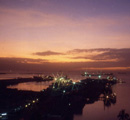
Manila Bay at sunset | | 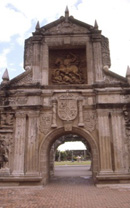
The Gate at Intramuros, the old city | | 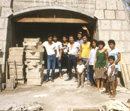
Workers rebuilding Intramuros after WWII destruction | | 
The famous old Manila Hotel, once the home of General MacArthur | | 
Entrance Manila Hotel in the 1920s | | 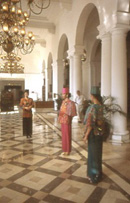
Entrance Manila Hotel today | | 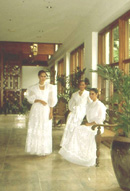
Before T-shirts, Filipinas once dressed beautifully | | 
How foreigners once thought Manila, the good life | | 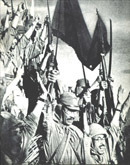
The Japanese invaded the Philippines in 1941 | | 
Manila has good shopping | | 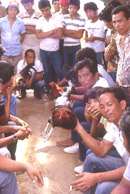
Manila one of the few places you can find cock fighting |
|





